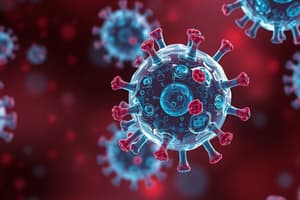Podcast
Questions and Answers
During the primary immune response, what is the main function of effector cells/molecules?
During the primary immune response, what is the main function of effector cells/molecules?
- Produce memory B and T cells
- Suppress the immune response
- Activate memory T cell subsets
- End an infection (correct)
Which of the following best describes the primary goal of a successful primary immune response?
Which of the following best describes the primary goal of a successful primary immune response?
- Promote the production of low affinity antibodies
- Activate effector cells to fight infections
- Suppress the immune response to prevent overreaction
- End an infection and create a reserve of memory B and T cells (correct)
What ensures that low affinity antibody is not produced in secondary immune responses?
What ensures that low affinity antibody is not produced in secondary immune responses?
- Reduced memory T cell subsets
- Activation of naïve B cells
- Enhanced effector cell function
- Mechanism involving memory B cells (correct)
What is the concept of original antigenic sin related to?
What is the concept of original antigenic sin related to?
What is the main function of immunological memory during a secondary immune response?
What is the main function of immunological memory during a secondary immune response?
How is immunological memory developed during the latter stages of the primary immune response?
How is immunological memory developed during the latter stages of the primary immune response?
What is the process of maintaining a memory cell population primarily related to?
What is the process of maintaining a memory cell population primarily related to?
In the context of B cells, what distinguishes a primary immune response from a secondary immune response?
In the context of B cells, what distinguishes a primary immune response from a secondary immune response?
What ensures that low affinity antibody is not produced in secondary immune responses?
What ensures that low affinity antibody is not produced in secondary immune responses?
In the context of T cells, what distinguishes a primary immune response from a secondary immune response?
In the context of T cells, what distinguishes a primary immune response from a secondary immune response?
What is the primary goal of a successful primary immune response?
What is the primary goal of a successful primary immune response?
What is the main function of effector cells/molecules during the primary immune response?
What is the main function of effector cells/molecules during the primary immune response?
Which cells maintain high antibody levels, preventing recurrence of seasonal diseases?
Which cells maintain high antibody levels, preventing recurrence of seasonal diseases?
What sustains immunological memory of a pathogen?
What sustains immunological memory of a pathogen?
Which cells are crucial during secondary immune responses?
Which cells are crucial during secondary immune responses?
What distinguishes memory B cells from naive B cells?
What distinguishes memory B cells from naive B cells?
Why is the activation of naive antigen-specific B cells suppressed during secondary immune responses?
Why is the activation of naive antigen-specific B cells suppressed during secondary immune responses?
What are the defining characteristics of memory B cells?
What are the defining characteristics of memory B cells?
What subsets of memory T cells are defined based on their characteristics and functions?
What subsets of memory T cells are defined based on their characteristics and functions?
Which cells are more abundant and easily activated compared to naive lymphocytes?
Which cells are more abundant and easily activated compared to naive lymphocytes?
What maintains high antibody levels in the bone marrow or beneath mucosal surfaces?
What maintains high antibody levels in the bone marrow or beneath mucosal surfaces?
Which cells sustain immunological memory of a pathogen?
Which cells sustain immunological memory of a pathogen?
What distinguishes memory B cells from naive B cells?
What distinguishes memory B cells from naive B cells?
Why is the activation of naive antigen-specific B cells suppressed during secondary immune responses?
Why is the activation of naive antigen-specific B cells suppressed during secondary immune responses?
Flashcards are hidden until you start studying
Study Notes
Immune Response and Memory Cells
- Primary immune response involves the formation of antibodies that prevent re-infection
- Successful primary immune response results in high levels of specific antibodies in blood, lymph, and mucosal surfaces for many months
- Long-lived plasma cells in the bone marrow or beneath mucosal surfaces maintain high antibody levels, preventing recurrence of seasonal diseases
- Long-lived memory T and B cells sustain immunological memory of a pathogen
- Memory cells, including memory CD8 T cells, memory CD4 T cells, and memory B cells, are crucial during secondary immune responses
- Memory cells are more abundant and easily activated compared to naive lymphocytes
- Memory B cells are isotype switched, high affinity, and can continue isotype switching/affinity maturation during subsequent infections
- Memory B cells express distinguishing features such as isotype switched/affinity-matured receptors and CD27
- The activation of naive antigen-specific B cells is suppressed during secondary immune responses due to the binding of immune complexes to inhibitory receptors
- Memory B cell responses in secondary immune responses are similar to and different from primary responses
- Memory T cell responses are similar to and different from primary responses, with differences in activation and circulation in peripheral tissues
- Two subsets of memory T cells, central memory T cells and effector memory T cells, are defined based on their characteristics and functions
Studying That Suits You
Use AI to generate personalized quizzes and flashcards to suit your learning preferences.




